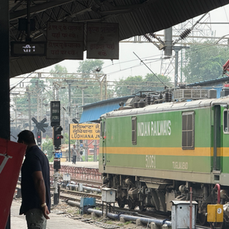DADU
I heaved my red tachi (suitcase) out of a taxi. Ludhiana’s train station was buzzing with people. At eighty-seven pounds, the tachi was nearly three-fourths of my body weight. I watched it like a hawk. My cousin noticed me looking at the bag. “No one will take it,” he commented. “You’re the only one who cares to drag this junk to Delhi!”

During the pandemic, I became curious about my Indian heritage. I’m mixed race and my exposure has been limited. I decided to call Dadu, my paternal grandfather, for the first time in March of 2020. Though I spoke no Hindi and he knew little English, we did our best to converse. Dadu sifted through his sparse selection of English phrases while I typed my questions into Google Translate.
Determined to communicate, I located a Hindi tutor and began learning Dadu’s dialect on Zoom. Our conversations slowly blossomed. During our calls, I earned the nickname “oy yaar ji,” a phrase meaning ‘dear friend.’
Dadu, like nine generations before him, passed his entire life in Ludhiana. He recounted the city’s legends for hours. After the Partition of India, businesses failed and, in lieu of a lasting solution, our family sold their belongings. Determined to help, Dadu left school at fifteen in order to support his family.
Dadu passed away in January of 2022. A desire to know more about him filled me. Ludhiana captured my attention.
I was born with an autoimmune disorder called Evans Syndrome. My doctor and parents believed an Indian vacation was not worth the health risk. I knew I needed a foolproof purpose to visit, and spent the entire winter of my junior year cold emailing Indian companies (one-hundred and twenty-one, to be exact) in search of a summer internship. In February, I accepted an invitation to intern at Samvitti Capital, a wealth management firm in Karnataka. Constant nagging made my parents relent. After an immune-boosting infusion, I went straight to the airport.
I planned a single, all-important weekend in Ludhiana. When my location icon on Google Earth crossed into Punjab, I clicked a screenshot. Everything—from the Punjabi women belting folk songs to the summer heat—melted away when I stepped onto the platform at Ludhiana Junction.
My first destination was Lal Qila (‘Red Fort’), our ancestral home. After Dadu’s death, the house was sold. ‘Too old,’ they told me. ‘Only Dadu loved it.’ I asked the new owner’s permission to visit. “How could I say no?” was his reply.
I traversed the ten-foot-wide street where Dadu had resided his entire life. After a bend in the road, Lal Qila came into view. Its decaying pink bricks outshone the surrounding homes. In Dadu’s absence, the residence became housing for nearby factory workers. Their sleeping mats were spread haphazardly across the floor. I peered into the room where Dadu was born. I crossed the courtyard where he had lain in state. One crumbling wall made me freeze. This room was his bedroom, the room he occupied during all our calls. I touched the ground and requested a blessing.
After his death, Dadu’s belongings were piled into a storeroom. I found a heap of heirlooms in a dark shed. Among the antiques, a hand-carved teak chest stood out. It was adorned with floral rosettes; five compartments covered the surface. When his family sold everything, Dadu saved this chest and used it to shelter his earthly possessions. I hoped to take it, but hesitated. ‘Too difficult,’ I thought. I changed my mind a few hours later and claimed it. I packed the chest and stacks of photographs into the red tachi.
I left Ludhiana the next day. Nothing compared to the joy of understanding Dadu. My oy yaar ji inspired my resilience. I later examined the red tachi’s contents. Maybe my cousin was right. Maybe that tachi was full of junk. But, to me, it was everything.















































